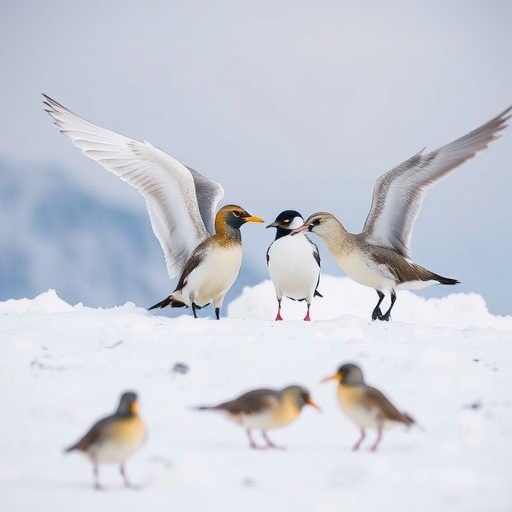In the inhospitable expanse of the Southern Ocean, a mesmerizing spectacle unfolds daily: diverse species of seabirds congregate alongside seals and whales, all converging to feast on the abundant swarms of krill just beneath the icy waters. This bustling scene, reminiscent of a nature documentary, masks a deeper ecological puzzle that has long captured the curiosity of scientists — how do such a variety of species so adeptly synchronize their foraging efforts within this vast and forbidding environment?
Antarctic waters are notoriously harsh and sparse, making the simultaneous discovery of food by multiple predator species a mystery. The challenge lies not only in surviving the cold and treacherous conditions but also in efficiently locating dispersed prey. Sönke Johnsen, a professor of biology at Duke University’s Trinity School of Arts & Sciences, remarks on the extraordinary nature of this ecosystem, highlighting how the intense competition for food is paradoxically matched by a form of cooperation evident in the behaviors of these seabirds.
Recent groundbreaking research published in the journal Proceedings of the National Academy of Sciences by Johnsen, postdoctoral scholar Jesse Granger, and University of California, Davis sensory ecologist Gabrielle Nevitt, sheds light on the intricate foraging networks that facilitate this multispecies interaction. The study delves into how multiple seabird species utilize different sensory cues in tandem to optimize their search for food, revealing a complex web of cooperation intertwined with competition.
Nevitt’s expertise in sensory ecology focused on how chemical cues, particularly dimethyl sulfide (DMS), play a pivotal role in guiding seabirds toward krill aggregations. Some species, including petrels and albatrosses, exploit their olfactory senses to detect trace amounts of this compound, which is released when krill feed on phytoplankton. These birds fly low over the ocean surface, tracing the scent like navigators of an invisible chemical map. Meanwhile, other seabirds occupy higher aerial strata, capitalizing on visual cues by observing the movements of their scent-tracking counterparts and following their lead to the feeding grounds.
This division of sensory labor exemplifies an evolutionary adaptation allowing multiple species to coexist and capitalize on the scarce and patchily distributed food resources without direct conflict. “Exploiting food resources is intensely competitive, yet finding them seems to require a cooperative sensory network,” Nevitt explains. Such interspecies reliance on complementary cues challenges traditional views that competition dominates such ecosystems and suggests a nuanced balance facilitating biodiversity.
Despite the challenges in directly observing these complex foraging behaviors in the wild, the team harnessed innovative computer modeling techniques to mimic and analyze the seabirds’ interactions. By treating each bird as an autonomous agent with specific sensory rules and behaviors—much like characters in a video game—Granger was able to simulate flocks with varying proportions of scent- and sight-oriented species. These simulations demonstrated how mixed-species sensory networks enhance overall foraging success compared to single-species groups.
Through iterative modeling, the researchers manipulated parameters to investigate how individuals responded to neighbors using complementary or identical sensory strategies. The emergent patterns from these simulations revealed that multispecies groups are more effective collectively; the presence of even a minority of scent-tracking birds improves prey detection rates for visually dependent birds. Conversely, a decline below critical thresholds in population size or species composition can precipitate a collapse of foraging efficiency, implying dire consequences for conservation.
This finding offers crucial insight into the vulnerability of Antarctic seabird populations, which are currently facing declines from environmental changes and human impacts. Maintaining balanced and diverse populations with varied sensory strategies could be key to the resilience of these communities, underscoring the importance of protecting multispecies assemblages rather than focusing solely on individual species.
Beyond its ecological implications, this research holds broader relevance for understanding the dynamics of complex systems comprising many individuals. As Johnsen illustrates, human crowds share parallels with these seabird networks. In chaotic environments like a state fair, where entry points are unclear, a small subset of individuals attuned to particular cues can guide collective movement, funneling the mass efficiently. This analogy suggests that sensory diversity and individual variation in cue sensitivity may underpin coordinated group behavior across biological systems, from animals to humans.
The study exemplifies how interdisciplinary approaches, combining sensory ecology, computational modeling, and behavioral biology, can unravel the subtle mechanisms governing ecological interactions. Supported by funding from the Air Force Office of Scientific Research and the National Defense Science & Engineering Graduate Fellowship, this work showcases the power of collaborative science to address foundational questions with far-reaching implications.
Looking forward, integrating such multisensory network models with real-world tracking data and environmental variables could enhance predictive capabilities for ecosystem management and species conservation. As climate change and anthropogenic pressures continue to reshape the Antarctic, understanding the behavioral ecology that supports these intricate foraging systems will be critical for sustaining biodiversity in one of Earth’s last frontiers.
With this work, Johnsen, Granger, and Nevitt not only illuminate the sophisticated strategies seabirds employ to thrive in an extreme habitat but also open new avenues for exploring how cooperation emerges from competition at multiple scales. Their insights invite reconsideration of how multispecies interactions are framed, emphasizing interconnectedness over isolation in the study of nature’s most resilient communities.
Subject of Research: Animals
Article Title: Multispecies sensory networks and social foraging strategies: Implications for population decline in procellariiform seabirds
News Publication Date: 6 October 2025
Web References: https://doi.org/10.1073/pnas.2509317122
References: Granger, J., Nevitt, G., & Johnsen, S. (2025). Multispecies sensory networks and social foraging strategies: Implications for population decline in procellariiform seabirds. Proceedings of the National Academy of Sciences. https://doi.org/10.1073/pnas.2509317122
Image Credits: Fernando Anido
Keywords: Behavioral ecology, Ecology, Ecological dynamics, Ecological modeling, Evolutionary ecology, Organismal biology, Animal physiology, Animals, Species interaction




